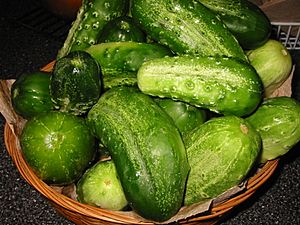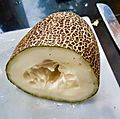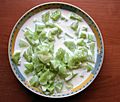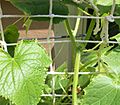Cucumber facts for kids
Quick facts for kids Cucumber |
|
|---|---|
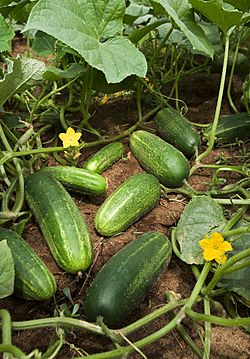 |
|
| Cucumbers grow on vines | |
| Scientific classification | |
| Kingdom: | |
| Division: | |
| Class: | |
| Order: | |
| Family: | |
| Genus: |
Cucumis
|
| Binomial name | |
| Cucumis sativus |
|
The cucumber (scientific name: Cucumis sativus) is a popular plant from the gourd family, called Cucurbitaceae. It's a creeping vine that grows fruits. These fruits are often used as vegetables in many dishes.
There are three main types of cucumbers: slicing (for eating fresh), pickling (for making pickles), and seedless (often called "burpless"). Many different kinds of cucumbers have been created within these groups.
Cucumbers first came from South Asia. But now, you can find them growing on most continents around the world. Lots of different types of cucumbers are sold globally. In 2014, the world produced about 75 million tonnes of cucumbers and gherkins. China grew the most, making up 76% of the total. In 2009, scientists even mapped out the entire genetic code of the cucumber!
Contents
What is a Cucumber Plant Like?
A cucumber plant is a creeping vine that grows roots in the ground. It likes to climb up trellises or other supports. It uses thin, spiraling parts called tendrils to wrap around things and climb. If there are no supports, the plant will spread out along the ground. It can also grow in water without soil, a method called hydroponics. The vine has big leaves that create a kind of roof, or canopy, over the growing fruits.
What Does a Cucumber Fruit Look Like?
The fruit of a typical cucumber is usually shaped like a cylinder. It's long with ends that get narrower. Some can grow up to 60 centimeters (about 2 feet) long and 10 centimeters (about 4 inches) wide. Even though it's technically a fruit, like a tomato or squash, people usually cook and eat it like a vegetable. Cucumbers are mostly water, about 95% of their weight!
Some cucumbers have a light melon smell and taste, depending on the type.
How Do Cucumbers Flower and Get Pollinated?
Most cucumbers have seeds and need to be pollinated to grow fruit. This means pollen from one flower needs to reach another. To help with this, thousands of honey bee hives are brought to cucumber fields when the flowers are about to bloom. Regular cucumber plants first grow male flowers, then female flowers, in similar numbers.
What Nutrients Do Cucumbers Have?
A 100-gram serving of raw cucumber (with its peel) is mostly water. It doesn't have a lot of essential nutrients. It's mainly known for having vitamin K, which provides about 16% of the Daily Value you need each day.
Different Kinds of Cucumbers
When people grow cucumbers, they usually sort them into three main groups: "slicing," "pickling," and "burpless."
Slicing Cucumbers
Cucumbers grown to be eaten fresh are called slicing cucumbers. These grow on vines with large leaves that help shade the fruit. People usually eat them when they are green and not yet fully ripe. This is because ripe, yellow slicing cucumbers can become bitter. Slicing cucumbers grown for places like North America are often longer, smoother, and have tougher skin. In other countries, they might be smaller with thinner, more delicate skin. You can also pickle smaller slicing cucumbers.
Pickling Cucumbers (Gherkins)
When cucumbers are preserved in vinegar or brine to add flavor and make them last longer, they are called "gherkins" (especially in the United Kingdom) or "pickles" (in the United States and Canada). While you can pickle any cucumber, the ones grown for commercial pickles are specially bred to be a uniform length.
Burpless Cucumbers
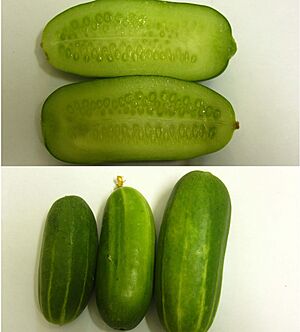
Burpless cucumbers are sweeter and have thinner skin than other types. Many people find them easier to digest and say they taste very pleasant. They can grow quite long, sometimes up to 2 feet! They have very few seeds and delicate skin. These cucumbers are often grown in greenhouses and are commonly found in grocery stores, usually wrapped in plastic. They are sometimes called "seedless" or "burpless" because the seeds and skin of other cucumber types can sometimes cause gas for some people.
Here are a few other types of cucumbers you might find:
- Lebanese cucumbers are small, smooth, and mild, but have a special flavor.
- East Asian cucumbers are mild, slender, deep green, and have bumpy, ridged skin.
- Persian cucumbers are mini, seedless, and a little sweet. You can find them in Canada during summer and all year in the US.
- Beit Alpha cucumbers are small, sweet, and grow well in the dry climate of the Middle East.
- Apple cucumbers are short, round cucumbers grown in New Zealand and parts of Europe. They are light yellow-green and mildly sweet.
- Schälgurken are eaten in Germany. Their thick skins are peeled, and then they are often cooked, sometimes with minced meat or dill.
- Dosakai is a round cucumber found in India. It's also grown in Central California.
- Kekiri is a smooth-skinned, hard cucumber from Sri Lanka. It's not used in salads but is cooked in spicy curries. It turns orange when it's ripe.
- In 2008, a British supermarket called Sainsbury's introduced the 'c-thru-cumber'. This type has very thin skin, so you don't need to peel it!
History of Growing Cucumbers
Cucumbers first came from India, where many different types have been found. People have been growing them for at least 3,000 years! They were probably brought to other parts of Europe by the Greeks or Romans. Records show cucumbers were grown in France in the 800s, in England in the 1300s, and in North America by the mid-1500s.
Images for kids
-
A varietal grown by the Hmong people with textured skin and large seeds
-
Dish with cucumber cut pieces (mizeria)
See also
 In Spanish: Pepino para niños
In Spanish: Pepino para niños



